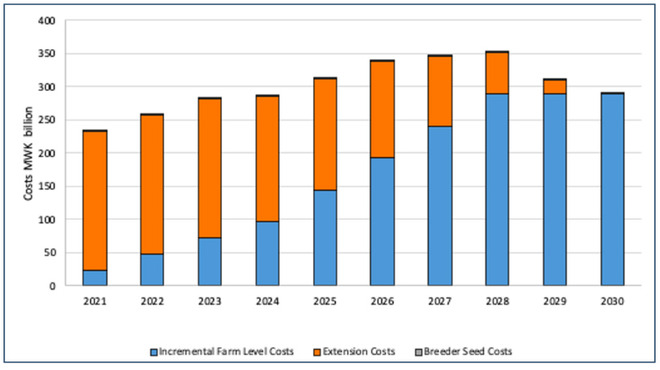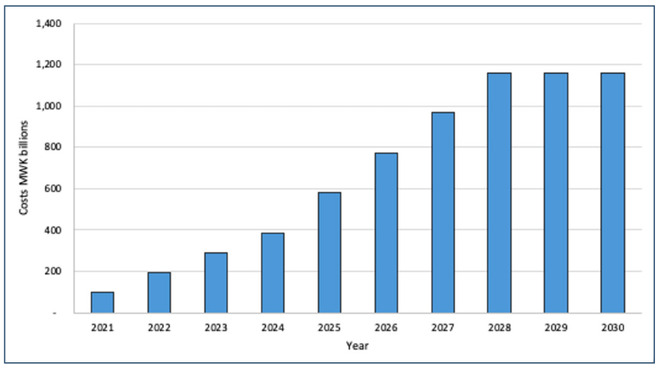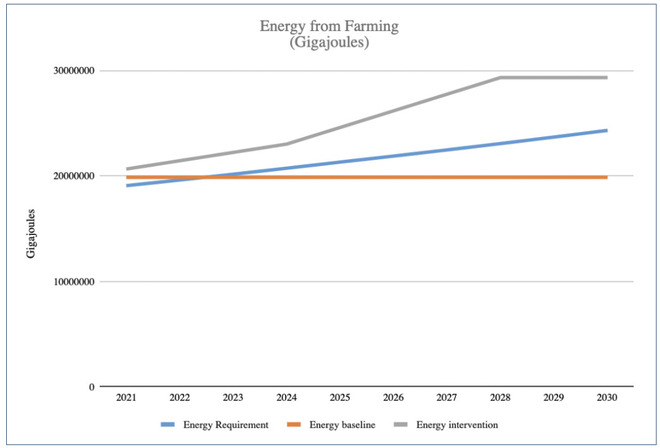Malawi Priorities: Food Security
Technical Report
Key Messages
- Food Insecurity remains a significant concern, with 63% of Malawian households deemed severely food insecure.
- Focusing on sustainable farming models, this cost-benefit analysis identifies two interventions that demonstrate significant promise in improving food security:
- Purdue Improved Crop Storage (PICS) Bags Promotion: PICS bags are a simple, hermetic storage technology that limits post-harvest losses to 9%, compared to 24-28% with traditional home storage approaches. A multi-year wide-scale promotion campaign, supported by subsidization, is expected to increase the use of the bags to 6 out of 10 farm households. This could generate almost 320,000 tonnes more maize available for household consumption, a benefit of MWK 64 billion per year by 2030. The bags are priced at 5 times higher than current methods. The cost of promotion and bags is MWK 245 billion over 10 years This cost could be split between farmers and the government through a subsidies program. By 2030, the net benefits of the intervention would be worth 0.4% of GDP. This intervention generates a benefit-cost ratio (BCR) of 2.9.
- Specific Crop Diversification Strategies: This intervention requires increased extension support to encourage farmers to diversify into higher value and more nutritious crops, with the report recommending different strategies for Malawi’s differing agro-ecological zones. For example, in the Lower Shire agro-ecological zone, the report recommends conservation agriculture, stress-tolerant maize intercropped with sorghum or pigeon pea and rotated with groundnuts or cotton for the uplands. Rice relay with bio-fortified sweet potato is recommended for the flood plains. The benefits of crop diversification are higher farm incomes It would also lead to a national surplus of food that could be exported or used in agro-processing. The strategies would deliver MWK 97 billion in increased income initially, rising to MWK 1,160 billion. To attain these benefits would require an annual investment fluctuating between MWK 200 and 350 billion. The net farm income is substantial, valued at 7% of GDP in 2030. The BCR is 20.
Context
Food insecurity and undernourishment are linked to poorer subjective well-being, lower wages, lower economic growth, and higher mortality and morbidity. In the case of those living with HIV and AIDS, poor nutrition can increase the risk of mortality by 18%. Population growth and crop production shocks, in addition to other factors, have led to a significant increase in the number of Malawian households in need of governmental assistance, with the share of the population needing food assistance growing from 2 to 7 million between 2012 and 2017.
In 2020, 6 out of 10 Malawian households are deemed severely food insecure. Depending on the agricultural season, between 36% to 46% of Malawian households consumed less than 1,800 calories per day in 2020. The IHS5 found that 70% of rural households and 45% of urban households reported that they did not have sufficient food.
One of the NPC’s prioritized research questions was ‘What interventions might deliver sustained food and nutrition security, as well as greater dietary diversity within sustainable farming models?’ As food security is a markedly multidimensional issue, this technical report has focused on one particular lever which shows potential as a mitigation strategy: sustainable farming models. In the process to identify cost-effective solutions, two different interventions with significant benefits have been identified using cost-benefit analysis:
1. PICS bags Promotion
2. Specific crop diversification strategies
Intervention 1: Purdue Improved Crop Storage (PICS) Bags
The first intervention reduces post-harvest losses by promoting the usage of hermetic storage bags (PICS). PICS extend the longevity of existing crops, improving storage quality and the subsequent lifespan of harvested grain, mitigating the threat of rot and pests. At a PICS uptake rate of 60% across Malawi, the value of avoided grain loss would be equivalent to MWK 64 billion per year. These improved bags are reusable and twice as durable, but at MWK 1490, the cost per bag is 5 times higher than that of traditional storage methods. The total cost over 10 years adds up to MWK 123 billion, MWK 103 billion representing the extra cost of the PICS bags, and MWK 20 million for promotion. It is likely that the government would need to subsidize the PICS bags initially, though this could be gradually lowered and removed once the farmers understand the value of the improved bags. The BCR of the PICS bags and promotion is 2.9.
Intervention 2: Specific Crop Diversification Strategies
The second intervention helps farmers diversify into different high-value crops, which provide increased income and greater nutrition.
The majority of smallholders engage in monocropping, which has led to nutrient deficiency and the need to import other varieties of foods. A comprehensive government engagement and information campaign to encourage crop diversification would require an investment of MWK 200 to 350 billion annually in terms of increased extension costs, cultivation costs, and breeder seed production. Much of this cost would be borne by the government, if historical and present subsidization patterns continue, however, this could be reduced over time as the farmers become aware of increased benefits.
Within the proposed intervention, different high-value crops are recommended for different regions, paired with different cropping systems. For example, the intervention proposes bio-fortified sorghum and pearl millet in the Lower Shire Valley, paired with conservation agriculture, stress-tolerant crop varieties, and cereal-legume intercropping/rotation. For the Lakeshore, Middle, and Upper Shire, drought-tolerant, Pro-Vitamin A Maize, improved Rice, and Biofortified Sweet Potatoes among others are suggested, alongside maize/cassava, pigeon pea/ bean intercrop rotated with ground nuts/cowpea, pigeon pea intercropping, or cotton.
Despite these high costs, the strategies would deliver benefits equal to MWK 97 billion initially rising to MWK 1,160 billion in steady-state. Over a 10-year period, the BCR of this strategy is 2.0. While the BCR is relatively modest, it would have a large absolute impact on the Malawian economy with additional net farm revenue equivalent to 7% of GDP in 2030.
Figure 1: Costs and Benefits of PIC Bag promotion

Figure 2: Crop Diversification Costs

Figure 3: Crop Diversification Benefits (MWK)

Beyond farm income benefits, Malawi would have a surplus of calories, protein, and zinc that could be consumed, exported or used in agro-processing, a key pillar of the country’s Vision 2063. This does not mean that these deficiencies would be eliminated at an individual level since it is uncertain how such gains would be distributed across the population. Nevertheless, the results provide hope that Malawi can achieve the required food security, at a national level to help meet its goals.
Figure 4: Energy Contribution from Crop Diversification relative to Status Quo (if everything harvested is consumed in Malawi)

Summary Table
| Intervention | BCR | Beneficiary Group | Cost Per Farmer Per Year | Investment Cost (in MWK billions) | Benefits (in MWK billions) |
|---|---|---|---|---|---|
| PICS Bags Promotion | 2.9 Fair (100% economic benefits) | 4.2 million farm households targeted 60% uptake of PICS bags |
MWK 5850 | Starting at MWK 4.6 bn in 2021 and rising to MWK 18bn annually in 2030 | Avoided maize losses starting at MWK 5.4bn in 2021 rising to MWK 64bn in 2030 |
| Specific Crop Diversification | 2.0 Fair (100% economic benefits) | 4.2 million farm households ers targeted 60% uptake of diversification strategies |
MWK 64,000 | 200 to 350 MWK billion every year with 43% of costs for extension, 57% for incremental farm costs. | Increase farm income starting at MWK 97 bn in 2021 rising to MWK, 1,160bn in 2030 |
Note: BCRs are based on costs and benefits discounted at 8% (see accompanying technical report). BCR ratings are determined on the following scale Excellent, BCR > 15; Good, BCR 5-15; Fair, BCR 1-5; Poor, BCR < 1. This traffic light scale was developed by an Eminent Panel including several Nobel Laureate economists for a previous Copenhagen Consensus project that assessed the Sustainable Development Goals.
Download the full policy brief here.

